Invasive Species Spotlight: Southern Pine Beetle—an emerging threat to pines?
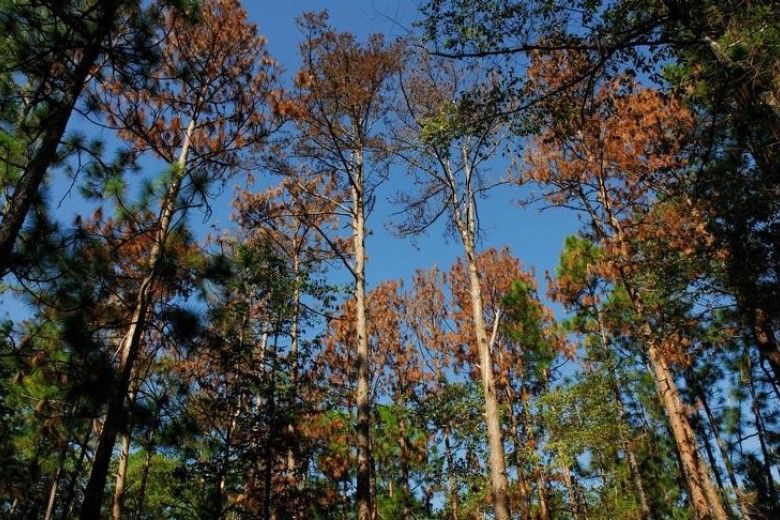
The southern pine beetle’s (SPB) diminutive size belies the lethal impact embodied in its scientific name: Dendroctonus (“Tree-killer”) frontalis. It is “the most destructive pest of pine in the southern United States.”
The SPB is heading north, expanding its native range as our climate warms. The historical range of the SPB includes northern Delaware and extreme southern Pennsylvania, as well as southern New Jersey. Cold winter temperatures kill off the beetles, but as average temperatures rise, the beetle has been wreaking havoc farther north, reaching the New Jersey Pinelands, Long Island and as far north as upstate New York and New England.
In 2017 a SPB infestation caused the death of 400 acres of pitch pines in Nottingham County Park, in southern Chester County. Subsequently SPBs infested trees at nearby Goat Hill and were even observed in northern Chester County in French Creek State Park. While not what we usually classify as an “invasive” species (exotic plants or animals imported far from their native range), the southern pine beetle’s increasing threat to our pine woods makes it worth our attention.
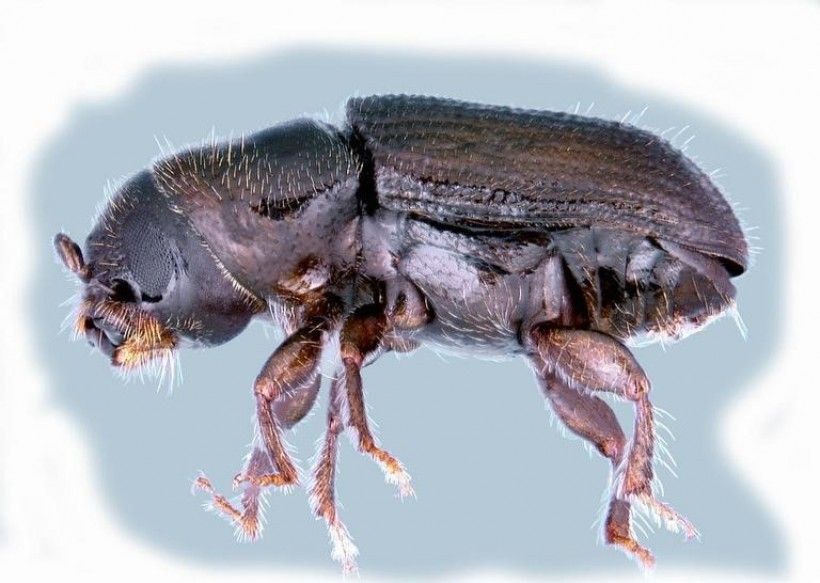
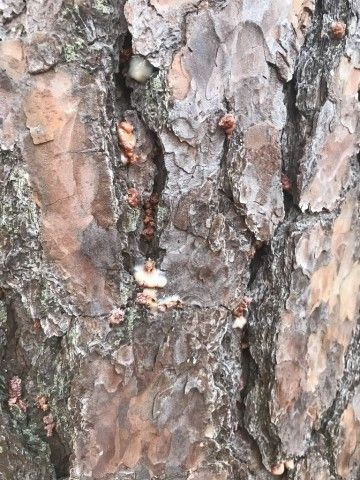
The beetles typically target lightning-struck, diseased, or stressed trees, which have fewer reserves to fight back. Such trees may not form pitch tubes, so an indicator of infestation is brown bark dust at the tree base or in bark crevices.
When they begin targeting a tree, adult female SPBs release pheromones, which attract many more beetles. This mass aggregation behavior overwhelms the tree’s defenses, especially if it’s unhealthy to start with. The females bore out “galleries” within the tree where they mate with males and lay eggs. Eggs hatch into larvae that tunnel within the tree, eating phloem, and creating “S” shaped galleries (visible beneath the bark layer). When the larvae morph into adults they tunnel out of the trees and fly off to colonize new trees, now in sufficient numbers that even healthy trees are susceptible to being overwhelmed. There are typically three or more SPB generations a year (depending on temperature), beginning in spring.
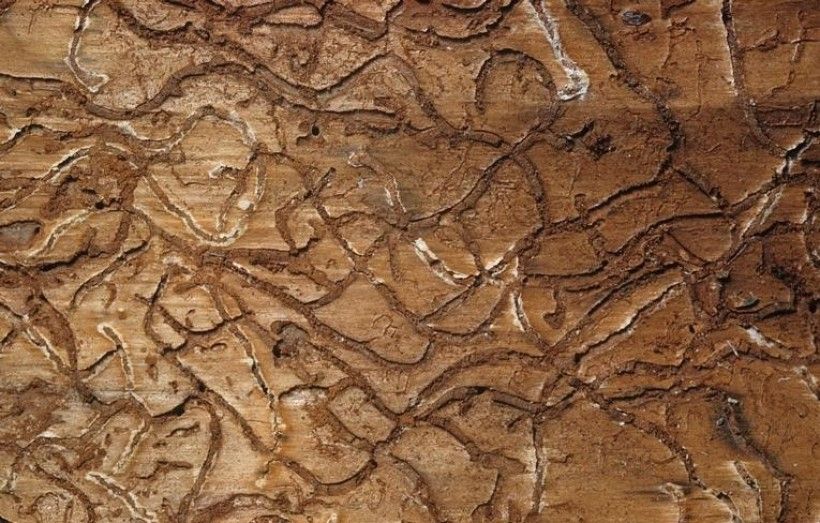
Unfortunately for the trees, the beetles’ activity is far from benign. The tunnels made by numerous beetle adults and larvae within the phloem layer effectively girdle the tree by cutting off its nutrient supply. Needle discoloration—yellowing in the crown—due to nutrient depletion is another indicator of infestation. Adult beetles also transmit a blue-stain fungus that is lethal to trees. Research indicates that SPBs may be deadlier in the north than in year-round warm regions because many more beetles mature at once.
The beetles do have natural predators such as woodpeckers and checkered (clerid) beetles. The presence of SPBs in a forest does not mean an outbreak is inevitable. When they do occur, outbreaks of SPB mortality in pine forests typically last two to three years. If the forest is large enough it can recover over time. Smaller stands will not recover as there are no seed trees from which the forest can regenerate.
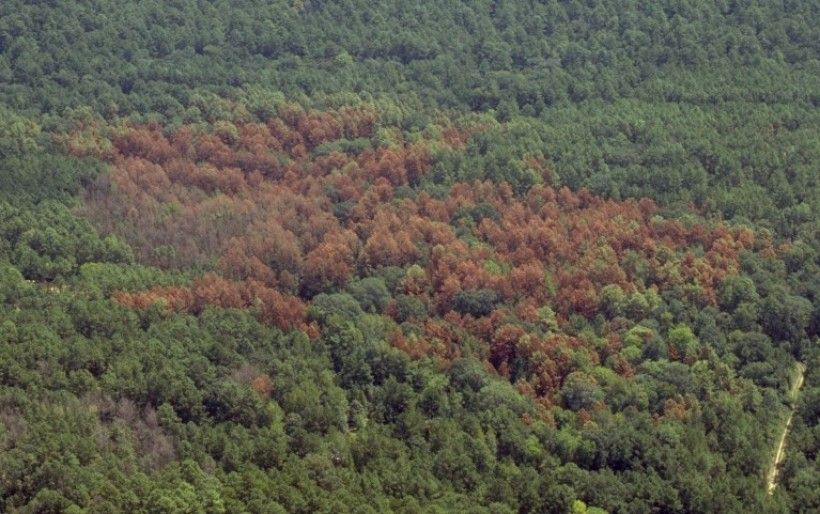
An important limiting factor in the spread of SPB into northeast states has been that the beetles’ preferred host trees are the Virginia pine, pitch pine, shortleaf pine and loblolly pine. In our region, natural stands of pitch pines are found in highly specific habitats: nutrient-poor, very acidic soil, including areas underlain by serpentine rock such as Nottingham County Park, and coastal pine barrens. Virginia pine is uncommon in our region but is frequently planted on Christmas tree farms. Loblolly pines stands are typically found regionally only if they have been planted (indeed they are the principal commercial tree in Delaware). Shortleaf tends to be a southern Delaware tree. (In rare cases SPB has also killed Norway and red spruce and eastern hemlock.)
The predominant native pine tree in southeastern Pennsylvania and inland northern Delaware is the Eastern White Pine, which the beetles do not favor—although a widespread Pennsylvania infestation in the 1930s did include white pines. However, just because the beetles have not munched through white pines in the past, doesn’t mean they won’t do so in the future. And white pines are susceptible to needle cast, fungal diseases and other concerns. “There is a general white pine decline in the Northeast,” according to Rick Hartlieb, Assistant District Forester for southeast Pennsylvania. Will white pines become the next frontier for Dendroctonus frontalis?
What you can do:
To protect your pines, reduce stress to the extent possible, for example by watering landscape trees during a drought. Monitor the health of your trees, whether in the landscape or in a woodland. Early detection of SPB may help prevent an outbreak. Isolated infested trees can be treated or removed to protect nearby trees. If you see indications of southern pine beetles—bark dust or pitch tubes; crown discoloration, S-shaped galleries—you should seek expert help to confirm whether the SPB is present. In Pennsylvania, contact the Bureau of Forestry William Penn District (610-582-9660). In Delaware, contact Bill Seybold, Delaware Forest Service Forest Health Specialist (302-698-4553 or [email protected]).
More information:
SPBs at Nottingham County Park and nearby serpentine barrens